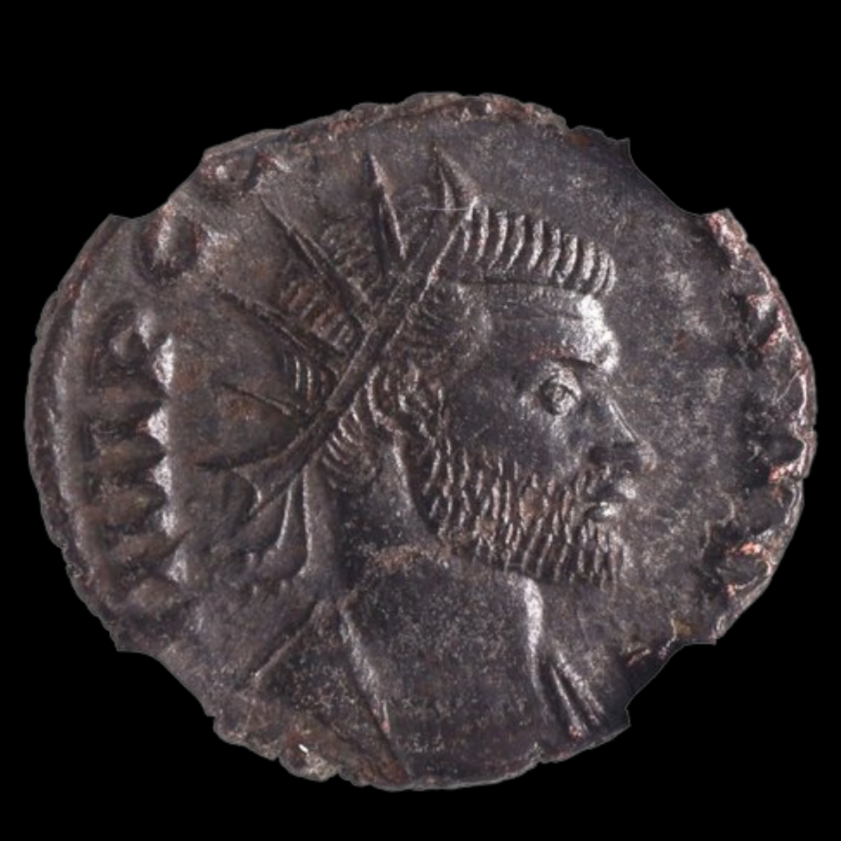 Image 1 of 12
Image 1 of 12

 Image 2 of 12
Image 2 of 12

 Image 3 of 12
Image 3 of 12

 Image 4 of 12
Image 4 of 12

 Image 5 of 12
Image 5 of 12

 Image 6 of 12
Image 6 of 12

 Image 7 of 12
Image 7 of 12

 Image 8 of 12
Image 8 of 12

 Image 9 of 12
Image 9 of 12

 Image 10 of 12
Image 10 of 12

 Image 11 of 12
Image 11 of 12

 Image 12 of 12
Image 12 of 12













Roman Bronze Coin of Delmatius (about 1,688-1,690 years ago)
The coins shown are representative examples of the grade and type, but not the actual specimens for sale. For details on NGC’s grading standards and definitions, please refer to our NGC Grading page.
This bronze coin features Delmatius (sometimes spelled Dalmatius), a nephew of Constantine the Great who was elevated to the rank of Caesar (junior emperor) in the final years of Constantine's reign. This rare coin was minted during Delmatius's brief two-year period of authority from 335 to 337 CE.
Coin Description:
Front side: Portrait of Delmatius facing right, likely wearing a laurel wreath or diadem, with his name and title "CAESAR" or similar imperial styling in Latin around the edge.
Back side: Probably features typical Constantinian imagery such as soldiers with standards, camp gate (GLORIA EXERCITVS), or Victory personification.
Technical Details:
Bronze alloy composition
Denomination: Likely a small follis or AE3/4
Weight: Approximately 2-3 grams
Diameter: Approximately 18-20 mm
NGC Certified for authentication and preservation
Minted between 335-337 CE
Condition as specified by NGC certification
Historical Significance: Born in Roman Gaul (near modern Toulouse, France), Delmatius was the grandson of Emperor Constantius I Chlorus through his father, who served as a censor. Constantine the Great appointed Delmatius as Caesar in 335 CE as part of his succession plan, giving him authority over Greece, Thrace, and parts of the Danube frontier. However, following Constantine's death in 337 CE, Delmatius was killed during the purge of Constantine's extended family orchestrated by Constantine's sons, who eliminated potential rivals to secure their own positions. This coin represents a brief chapter in the tumultuous succession politics following Constantine the Great's death.
The coins shown are representative examples of the grade and type, but not the actual specimens for sale. For details on NGC’s grading standards and definitions, please refer to our NGC Grading page.
This bronze coin features Delmatius (sometimes spelled Dalmatius), a nephew of Constantine the Great who was elevated to the rank of Caesar (junior emperor) in the final years of Constantine's reign. This rare coin was minted during Delmatius's brief two-year period of authority from 335 to 337 CE.
Coin Description:
Front side: Portrait of Delmatius facing right, likely wearing a laurel wreath or diadem, with his name and title "CAESAR" or similar imperial styling in Latin around the edge.
Back side: Probably features typical Constantinian imagery such as soldiers with standards, camp gate (GLORIA EXERCITVS), or Victory personification.
Technical Details:
Bronze alloy composition
Denomination: Likely a small follis or AE3/4
Weight: Approximately 2-3 grams
Diameter: Approximately 18-20 mm
NGC Certified for authentication and preservation
Minted between 335-337 CE
Condition as specified by NGC certification
Historical Significance: Born in Roman Gaul (near modern Toulouse, France), Delmatius was the grandson of Emperor Constantius I Chlorus through his father, who served as a censor. Constantine the Great appointed Delmatius as Caesar in 335 CE as part of his succession plan, giving him authority over Greece, Thrace, and parts of the Danube frontier. However, following Constantine's death in 337 CE, Delmatius was killed during the purge of Constantine's extended family orchestrated by Constantine's sons, who eliminated potential rivals to secure their own positions. This coin represents a brief chapter in the tumultuous succession politics following Constantine the Great's death.


































